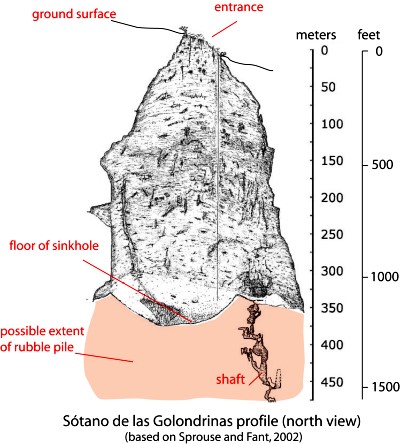El Sótano de las Golondrinas, in the municipality of Aquismón in the state of San Luis Potosí, is a massive limestone sinkhole (pit cave), one of the largest known in the world. In terms of depth, it is thought to be the second deepest sinkhole in Mexico and is probably in the world’s top 20.
The depth of sinkholes can be difficult to determine. For example, in the case of El Sótano de las Golondrinas, its surface opening is about 50 meters by 60 meters (160 by 200 ft) in size, but is on a slope. The depth on the high side is about 376 meters (1220 ft); the depth on the low side is about 330 meters (1090 ft).
Below the surface (see profile) the sinkhole is roughly bottle-shaped. The floor of the sinkhole is about 300 x 135 meters (990 by 440 ft) in area. However, the sinkhole is believed to have formed from the collapse of the roof of an underground cave. As a result, the floor of the sinkhole is not solid rock but rubble that presumably came from the walls and former roof. A shaft on one side extends down at least another 100 m, suggesting that the true floor of the original cave lies at least that far beneath the current rubble-strewn floor.
US photographer Amy Hinkle shot some spectacular images earlier this year in this cave. The accompanying article highlights the “secret garden” that “nestles 300 meters beneath the surface of the earth”.
The cave’s name (literally “basement of the swallows”) derives from the thousands of white-collared swifts that inhabit the overhanging walls of its interior. They spiral out of the cave every morning over a period of 25-30 minutes and return to their cave homes close to sunset. Large numbers of green parakeets also live in the cave.
The floor of the sinkhole is home to a rich plant life, as well as a diverse selection of fungi, millipedes, insects, snakes, and scorpions.
The original cave is thought to have been formed by a lengthy period of water erosion along a major fault line in the lower Cretaceous limestone in the Sierra Huasteca (part of Mexico’s Eastern Sierra Madre). Over time, the cave became larger as a consequence of both the water erosion and due to mass movements (landslides, rockfalls) on its walls. Eventually, the size of the cave was so large that its walls could no longer support its roof which then collapsed into the cave, leaving the open air sinkhole seen today. Following heavy rain, short-lived waterfalls cascade down the sides of the sinkhole.
The first documented exploration of El Sótano de las Golondrinas was apparently in 1966. Since that time, the cave has become a popular destination for various adventure sports including rappelling, abseiling and base jumping (no longer allowed).
There are several other very deep sinkholes in the same general area, including Hoya de las Guasguas (with a 202 m deep entrance shaft) and Sótano del Barro (402 m in depth).
Some ornithological studies have found that the bird population of El Sótano de las Golondrinas is decreasing, perhaps due to the disturbance caused by the increasing number of human visitors. To limit disturbance, access and activities are more tightly controlled. For instance, descents into the cave are now strictly limited to daylight hours when the birds are absent, and a no-fly zone has been established around the cave, primarily to avoid helicopter disturbance.
El Sótano de las Golondrinas is yet another outstanding example of a geomorphosite in Mexico. Mexico has literally thousands of geomorphosites. Among those described in previous Geo-Mexico posts are:
- the world’s smallest volcano in Puebla
- Copper Canyon in Chihuahua
- Paricutín Volcano
- the Basalt Prisms of San Miguel Regla, Hidalgo
- Piedras Encimadas
- El Zacatón sinkhole in Tamaulipas
- Enchanted Lake in Veracruz
- the Los Negritos mud volcanoes in Michoacán
- the volcanic spine of Tequila Volcano, Jalisco
- the Piedras Bola (Stone Balls) of the Sierra de Ameca, Jalisco
- Peña de Bernal, a monolith in Querétaro
- The crater lake of Santa María del Oro
References:
- Sprouse, P and Fant, J, 2002. Caves of the Golondrinas area. Association for Mexican Cave Studies Bulletin, 10, 74pp.
- Irma Brígida Suarez Rodríguez, Alejandro Gutiérrez Hernández & Alma Rafaela Bojorquez Vargas. Sótano de las golondrinas…Maravilla natural de México, acciones para su conservación como destino de turismo de naturaleza.
Related article:

Sorry, the comment form is closed at this time.